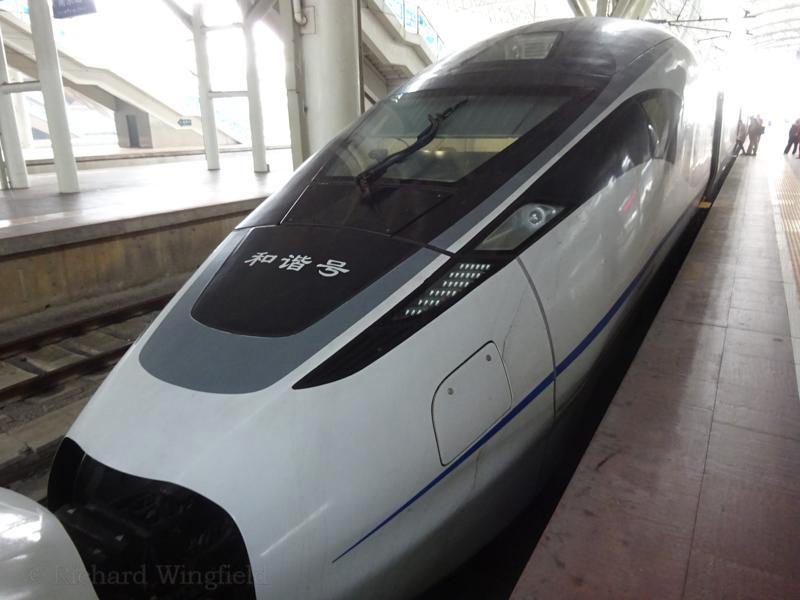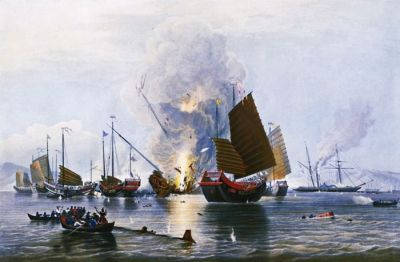Chinese Railways
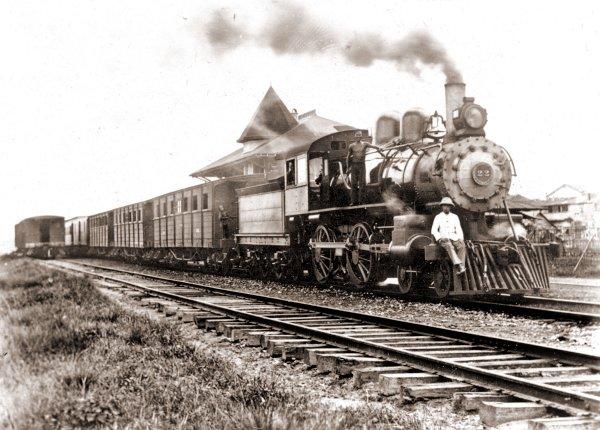
The tale of the building railways documents the difficult times in China during the period 1870-1949. Not only was development beset with national and local opposition but it was a dispute over the railways that sparked both the fall of the Qing dynasty and the Japanese occupation. Since 2000 China has developed a world beating railway network.
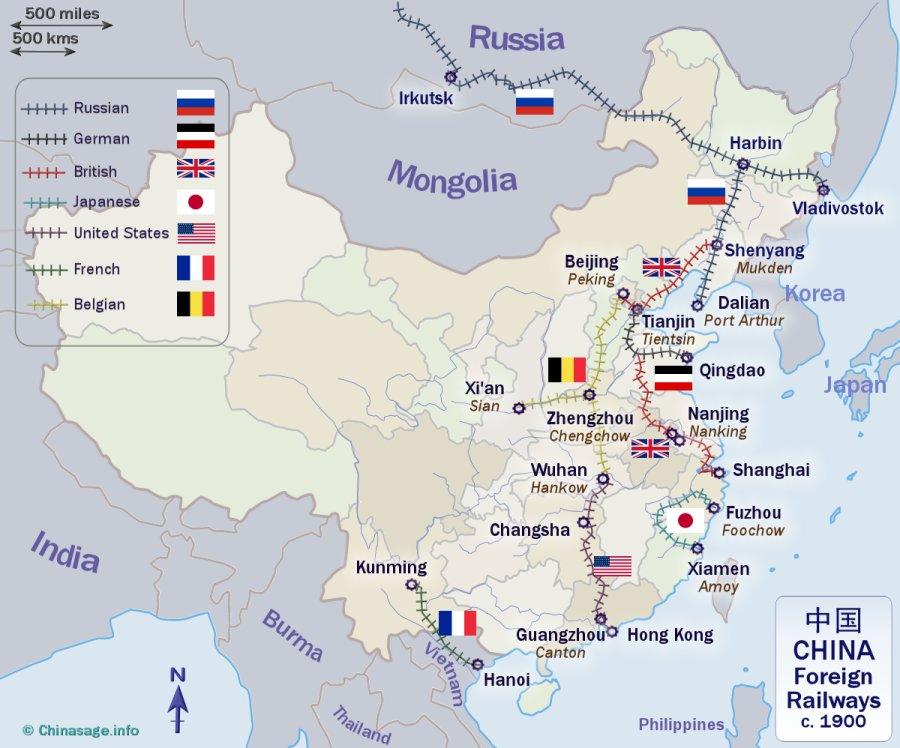
Before railways
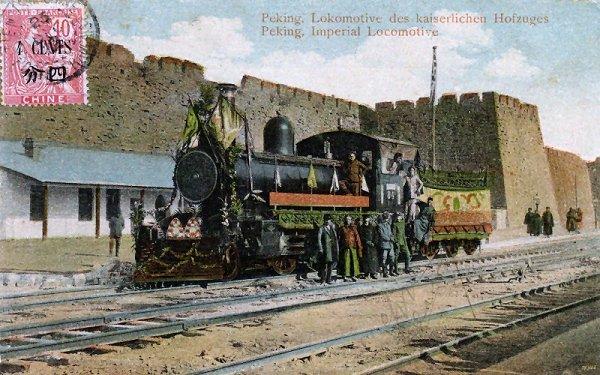
After the signing of the Treaty of Tianjin in 1860 that ended the Opium Wars, Britain and France expected to reap rich rewards. A group of foreign Shanghai businessmen proclaimed ‘A crusade of commerce… The honor of opening-up the resources of an ancient Empire.’. Railways were to be the chief instrument for opening up the trade. By the 1850s Britain had built a flourishing network of railways in India to the delight of their shareholders. While in America by 1850 about 9,000 miles of track had already been laid and by 1860 nearly every major city had a railway station. This was the golden age of railway expansion. Railways brought quick and cheap transport of manufactured goods to new markets and just as importantly allowed heavy raw materials to be extracted from forests, mines and quarries. Moreover the railway companies could use them to impose control over a whole region.
At this time China had a very poor transportation system, apart from the slow Grand Canal most transportation was on dirt tracks with a good proportion still carried by foot.
Early setbacks
The UK as the foremost world power at the time had its sights on developing the Yangzi valley and extending the Indian Empire eastwards through Burma into China. Captain Margery led a small expedition to survey a possible railroad from Bhamo in Burma (on the upper River Irrawaddy) to Shanghai. After surveying westwards from Shanghai and meeting Colonel Browne he was murdered by Chinese on his return on 21st Feb 1876. Uproar on his death in Britain led to further reparations being exacted from the Qing government. Britain went on to take the kingdom of Burma 1886, which had up until then shown fealty to the Qing Empire.
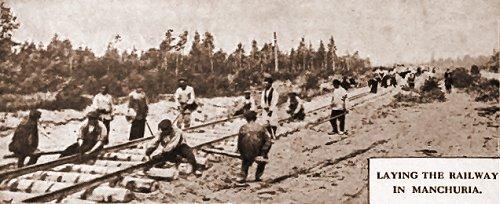
In Shanghai, entrepreneurs, once again led by the British, built a short 15 miles [24 kms] railway north to Baoshan in 1876 (aka. Woosung WG) on the banks of the Yangzi. This met with some local opposition because of the belief that railways bring very bad Feng Shui. In Feng Shui a straight line allows damaging sha qi to move too rapidly and this effect is made worse by the hard, cold metal tracks. To mitigate this influence un-necessary curves were added to the route of the track. The railway engines were considered demonic and devilish as they spewed smoke and burned coal. However crowds did come to view this wonder of the modern age. Just as potent were the fears of unemployment, prior to railways virtually everything was carried on the backs or in the wheelbarrows of porters; the railways posed a real threat of unemployment and financial ruin. To quell the unrest the Qing government bought up the railway in 1877, only to have it dismantled and sent to Taiwan. This was a most inauspicious start to railway development in China.
However, some Chinese could see the benefit of the railways. In 1877 the Chinese ambassador to the UK, Guo Songtao ➚, wrote to Li Hongzhang extolling virtues of the British railway system, he was particularly impressed by the high speed - 30 miles per hour!
Fits and starts

It was only in the 1880s and 90s that railway building really got going in China. The first functional 50 miles [80 kms] railway built in 1881 ran north from the port of Tianjin to Tangshan, Hebei (known as the Kaiping Tramway ➚).
The Qing government at first saw the railways as a threat, as they allowed foreign troops, missionaries and their influence to penetrate deep into China. Railway companies were given full control of territory in a twenty mile wide corridor, here, foreign not Chinese laws applied just as in the concessions. The convention that the emperor owned everything gave rise to problems over ownership - foreign powers could only lease and not own the land. They could be used to move troops and armaments with little government control over them. The Dowager Empress forbade a railway to go within Beijing's walls. However a minister built a miniature railway donated by the French within the Forbidden City between the living quarters and a dining hall; but eunuchs rather than a steam railway engine pulled the carriages as an engine was considered such bad feng shui. Concerns about these ill effects caused a proposed railway to be routed around Confucius' birthplace at Qufu, Shandong. It was only the dire financial situation that forced the Qing government to permit Britain, Russia, Japan and Germany to build railways from their concessions that by then were dotted all over China. In 1898 with only 495 miles [797 kms] in existence, the government agreed to demands to build 6,600 miles [10,622 kms] of new track. The government had no money to build its own railways.
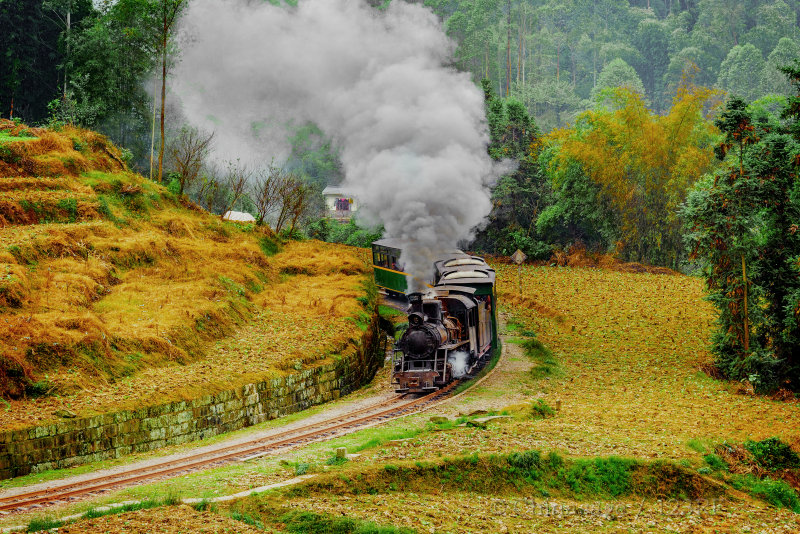
Trans-Siberian Railway
Russia was particularly keen because in 1860 Vladivostok (which means 'Lord of the East') had been taken from China, and this warm water base on the Pacific would only be viable if it had a railway link through Siberia all the way to Moscow. In March 1890, the future Tsar Nicholas II visited Vladivostok and pushed through the building of the Trans-Siberian railway ➚'s eastern section based on the plans of Sergei Witte ➚. Although Russia could build a section along the north of the Heilongjiang (Amur) river the more direct route was through Qing controlled Manchuria. Li Hongzhang went, in secret, to Moscow and pocketed a 3 million rouble bribe to seal the ignominious deal. After the Sino-Japanese War (1894) Japan took control of Liaoning, but France, Germany and Russia mounted a determined ‘Triple Intervention ➚’ in 1895 to eject Japan from Liaoning, and Russia was the main beneficiary. The Trans-Siberian Railway opened in 1904 and proved a faster and cheaper conduit for goods into China than by sea. The Russians built the Chinese Eastern Railway 1897-1903 together with the important 440 miles [708 kms] branch line from Harbin to Dalian (then called Port Arthur). Harbin remained a Russian dominated railway hub until the Sino-Soviet split in 1952.
Boxer Rebellion

The Boxer Rebellion (1898-1901) attacked all things foreign, including their new fangled railways. The Tianjin-Tangshan link which had by 1897 been extended to Beijing was often sabotaged and because it was also frequently damaged by floods, it had not proved itself as a reliable transport route. The Qing government began to see that railways could be just as important for defense as attack, troops could be moved quickly to trouble spots and if a railway was in danger of enemy capture they could be easily sabotaged and the tracks torn up, trapping the enemy. This tactic was brought home when the international relief force came to break up the Siege of the Legations ➚ (1900) in Beijing. They marched on foot and chose not to use of the railway because it was seen as too risky. At the end of the Boxer Rebellion the Western powers were able to exact even more advantageous conditions from the Qing, now in terminal decline. The railway companies were given free rein. A railway line was driven through Beijing's city walls. By 1911 the majority of the 6,000 miles [9,656 kms] of railway in China was under foreign control.
Carving up China

Foreign powers could now build railways to shore up their interests in China: Russia in Manchuria; France in Yunnan; Britain in the Yangzi valley; Germany in Shandong; Japan in Fujian and Taiwan. By 1902 Foreign investment into China had risen to $1,610 million with Britain contributing the most: $607 million.
Note: For ease of referring to other documents some of the old Wade Giles names are given after the modern Pinyin spelling of place names in brackets.
The Qingdao-Jinan Line in Shandong was completed by Germans in 1904 and then taken over by the Japanese after WW1. The rights to build the line came from reparations over the death of German missionaries ➚ in 1897.
France extended the influence of its French Indo-China Empire (Cambodia, Vietnam, Laos) into China by building the Hanoi-Kunming line in 1904-1910. France had its eye on the extensive tin mines of Yunnan as well as transporting general goods. It was the only metric gauge railway in China.
Japan, which had taken over Taiwan (Formosa) at the end of the Sino-Japanese War (1894-95) built railways there and extended its influence into China with plans for railways in Fujian servicing the ports of Fuzhou (Foochow WG) and Xiamen (Amoy WG), however extensive corruption and the mountainous terrain led to only 3 miles [5 kms] actually being built by 1910.
Some lines were financed by a loan paid to the government by the foreign power which then ran them until the loan was repaid. This was an irresistible arrangement because of the hopeless state of the Imperial finances which made full repayment a very unlikely possibility.
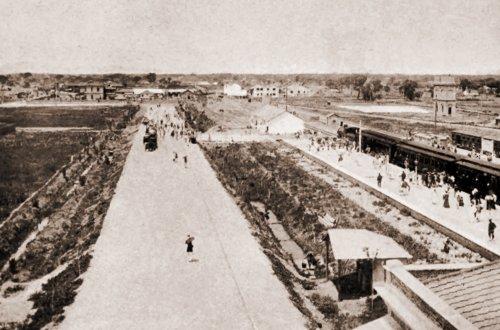
In 1898-1910 Britain built the important line from Beijing to Shenyang (Mukden WG). During the Boxer troubles this had come under direct British Army administration (1900-1902). Following an agreement in 1898 Britain and Germany jointly built the line from Tianjin to Pukou (1908-1912). Pukou was on the northern bank of the Yangzi. There was no bridge over the Yangzi river to Nanjing at this time; trains were split into their separate carriages and transported over the river in boats and then re-assembled on the opposite bank. Britain also built the Shanghai - Nanjing line, reinforcing Britain's control of the lower Yangzi. She also moved to stop rivals building new railways by blocking their plans in case they might damage her interests; for example, an American plan to build a line to Chengdu, Sichuan was scuppered by Britain.
A country late in on the act of exploitation of China was Belgium. King Leopold was delighted to win the rights to build the Beijing-Hankou (now part of Wuhan) line in 1896 which was completed in 1905. However Britain and France saw this as unwelcome competition and so bought out the rights from the Qing government in 1908.
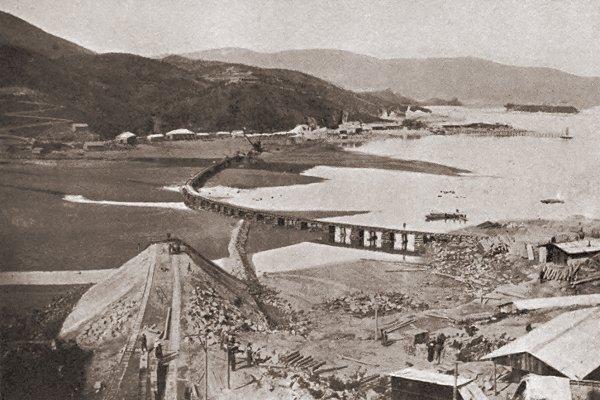
America had been long been active in the trade to Guangzhou (then most widely known as Canton), she won the rights to build the important North-South line from Guangzhou to Hankou. Progress was slow as high mountains block the route. The Guangzhou-Shaoguan section was completed by 1916 and lastly from Shaoguan to Zhuzhou. But it was not until 1936 that direct, fast travel from Guangdong to Beijing was at last made possible.
The only railway built and owned by the Chinese was built between 1905 and 1909. It was a short one ( 121 miles [195 kms]) from Beijing to Zhangjiakou (Kalgan) in Hebei.
Civil unrest
In late Qing times popular antagonism against the foreign powers led to the founding of the popular ‘Rights Recovery Movement’ in which people were encouraged to buy shares in rail companies so that they would become Chinese owned and run. It was questions over ownership of the railways that led to the downfall of the Qing dynasty in 1911. The ever rebellious and independent people of Sichuan objected to a government plan to nationalize the railways. The nationalization would have robbed the local Chinese merchants and gentry of their shares in the railroad companies especially the planned Hankou-Sichuan line. The foreign powers were not too unhappy about the nationalization as it would have actually extended their control over them because the Qing were in such financial and administrative disarray. The dispute led to the uprising that toppled the Qing dynasty from power and brought in the Republic of China.

Republican Era
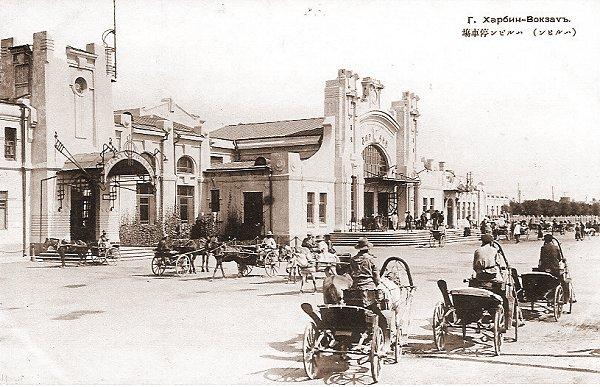
The new Republican government (1912) was keen to modernize China, and railways were expected to play a key part in that. However Republican attempts to build new railways were thwarted by rivalry between war lords who controlled a patchwork of territories in China, particularly in the north. They saw moves to build a national network as a threat to their power bases. For example, in the 1929 famine (Henan, Shaanxi and Gansu) local warlords prevented trains transporting food for fear that rivals would steal the trains, three million people died of starvation as a result. Railways were often used in battles between rivals to transport troops, arms and munitions. Some warlords raised funds to try to buy control of the railways through their territories. This was all bad news for the railway companies as they were unable to implement long distance travel (freight and passengers) because of the lack of a national network.
A turning point came in with World War 1 (1914-18) when Western investment dried up and into the 1920s very few new railways were built. Only poor dividends could be paid to shareholders. In the early 1930s many of the railways went bankrupt (mainly in northern and central China) and the foreign investors lost their money - share certificates of Chinese railway companies became worthless and are now displayed as works of art.
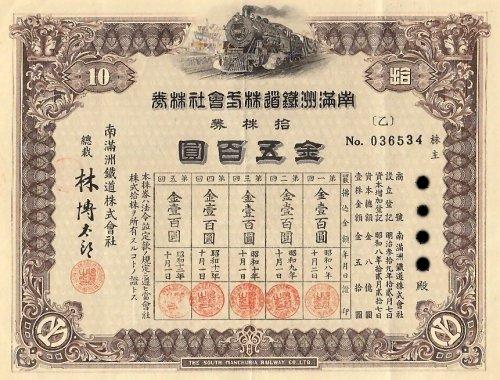
During the Japanese occupation of China the railways were used to support their invasion. In despair the last european investors and managers left in 1941. The Japanese then expanded the rail network in Manchuria to exploit coal, iron and other resources. By the end of WW2 there was 3,000 miles [4,828 kms] of track in Manchuria with only 14,000 miles [22,531 kms] elsewhere in the whole of China. In return for Allied Chinese support in World War II, the many foreign concessions were officially given back to China.
People's Republic

The new government in 1949 inherited a broken and inadequate railway system. A priority was to build and modernize the network after twenty years of damage in the Japanese Occupation and then Civil War. Many provinces had no railways at all, including the strategically important province of Sichuan. The most westerly line ran only as far as Xi'an, the sparsely populated and mountainous terrain of western China had made the area unattractive to foreign investors. Many parts of the main Beijing-Hankou line had been destroyed and needed rebuilding.
The first five year Communist plan (1952-57) aimed to rapidly build links, for military purposes as much as anything, so the nation could be held together. A line into Fujian allowed troops to be sent to defend the Fujian coast against possible GMD attack from Taiwan. Railway links were made with to the then friendly Communist governments in Mongolia, Vietnam and Russia.
In the first 25 years the PRC doubled the size of the network. At last a line was built from mountainous Yunnan to Sichuan. The network expanded into Xinjiang in 1960-75 to the strategically important Urumqi oilfields. The lines also were extended to join up with the Russian Turkestan-Siberian railway at Druzhba.
Cracking China book

Your A-Z key to understanding China
We are proud to announce a printed book all about China based loosely on this web site. It is a set of sixty topics in A-Z order covering everything from hair to kiwifruit, clapping to rhubarb, eunuchs to dragons. Buying a copy will help support Chinasage. Now available as a Kindle eBook for just $3.90.
Details... ➚Modern Times
Even as recently as the year 2000, China had a poor network. There was only 4% of the world's railway track serving 21% of world population. The quality was basic too, with two-thirds still single rather than double track. The western provinces were poorly served, and only the dramatic growth in air transport filled the gap. Surprisingly it was cheaper to import coal by sea from Australia than transport by rail across China.
Recently there has been much increased government investment and the Chinese railway network has been transformed. A key figure was Liu Zhijun ➚ who oversaw a vast increase in investment 2003-2011 before being dismissed for vast scale corruption. The initial stimulus brought in foreign expertise from leading world firms which was then copied by local train manufacturers. The railway sector now has 2 million employees with a 20,000 railway police force.
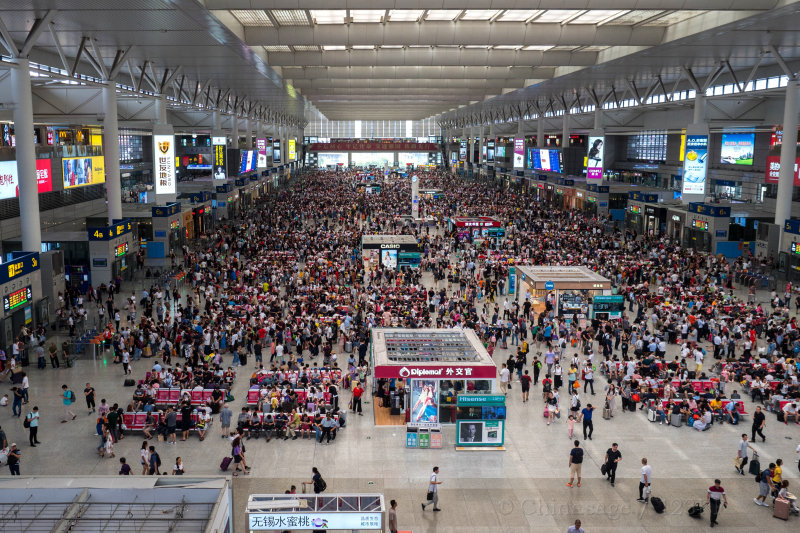
The network had been extended by 2008 to 23,500 miles [37,820 kms] linking all the major cities. Even so a doubling of this network is planned for 2035. These new lines can all take high speed trains (typically 217mph [350kph]) making them competitive in speed and cost to airline travel. This makes China the most advanced nation for high speed trains. Around 10,000 high speed trains make journeys each day. The new network is allowing new areas to be brought into rapid economic development. The technology initially came from foreign railway companies but now it is native Chinese companies that do the construction of trains and track. Construction is fast, typically five years from approved plan to opening. Over urban areas, mass demolition of houses is avoided by raising the track onto elevated sections.
The expanded network now extends to neighboring countries including Laos and there is a plan to link to Singapore via Thailand. It will also have improved links through Central Asia as part of the Belt and Road initiative.
Passengers book tickets online in advance and only need to show their ID app to embark on a train, paper tickets are rarely used. Some trains are driver-less including the fast bullet train built to service the Beijing Winter Olympics 2022 ➚ at Zhangjiakou 108 miles [174 kms] in 45 minutes.
China has moved to the latest train technology. The Magnetic Levitation (Maglev ➚) system (invented in the UK but never used there) allows faster speeds (probably 350mph [620kph]) as there is no wheeled contact with the track. This technology has been used in Japan for some time but not on a large scale. This very expensive Maglev track is being planned for use on a line linking Guangzhou and Hong Kong.
The railway bridge running from Danyang to Kunshan ➚ is currently the longest in the world. It is called the 丹昆特大桥 Dān kūn tè dà qiáo and is 105 miles [169 kms] long. It was built to elevate the railway above the low-lying ground along the route of the Grand Canal between Nanjing and Shanghai, it was opened in 2011.

Lanzhou - Tibet railway
The last province to receive a railway link was Tibet. A link from Lanzhou to Xining in Qinghai was built in 1959 and then the line was extended to Golmud in 1984. The final section was built 2001-2005 over the high Tibetan plateau by starting at both ends (Lhasa and Golmud). The highest railway in the world opened on 1st July 2006, it is at so high an elevation that oxygen masks are provided for passengers. Special measures were needed to stabilize the track as it runs over permafrost ground and also to provide gaps for wildlife to migrate unhindered.
